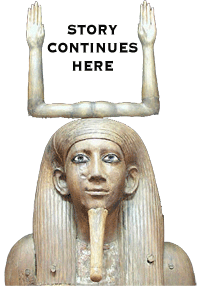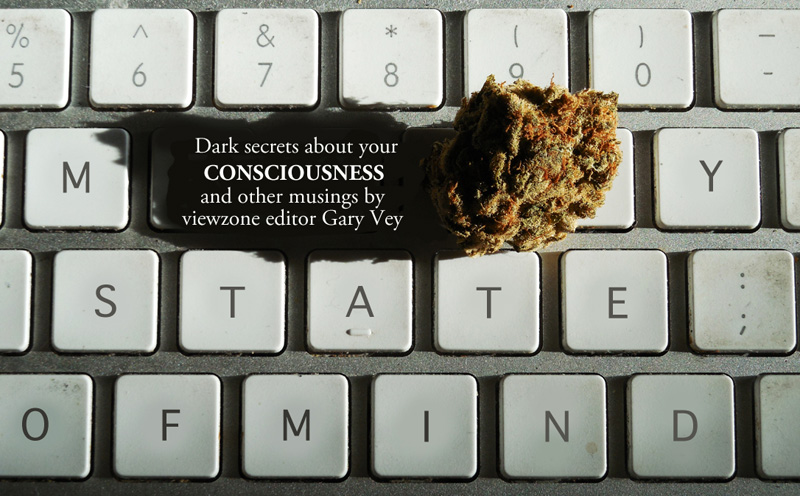
Where are the hidden traces left by the Gods?"
-- Rig Veda
Who are we -- really?
At this place in the story -- between the apparent "awareness" of the electron and describing our own true nature -- I must mention a significant clue that links the two. What I am about to describe is not easy to understand at first. But it is an accepted fact in physics.
I have written a detailed explanation for you HERE, with animations, to explain something quite amazing that was first observed in experiments with light beams back in 1803.
Physicists use the term "light" to mean energy in the electromagnetic spectrum. Because of this, what is true of photons also applies to electrons. The phenomenon I'm about to describe is the most amazing discovery that I have come upon and one that still excites me.
Simply put, a single, solitary electron (or photon) traveling through a screen with two closely spaced, small holes, will display a scatter pattern on a target screen as if it went through both holes at the same time and interfered with itself. This is to be expected if light (photons and electrons) are waves and not discrete particles or packages of energy.
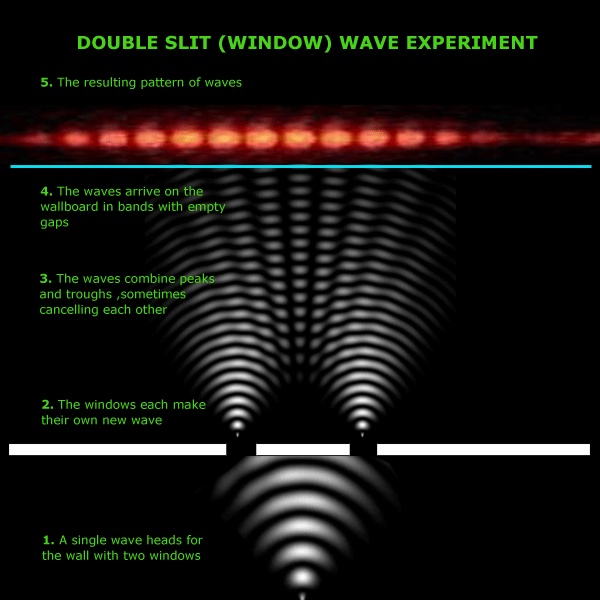
But the real surprise comes when someone tries to determine which hole in the screen the electron passed through. For some unexplained reason, any time the electron is observed during its trajectory the scatter pattern changes to indicate that it is a particle, not a wave.
In other words, if a mind is able to detect and "know" the path of the electron (or photon) then it will behave like it was a particle. If a mind does not "know" the path then its trajectory, it will be different and behave like a wave.
No matter what scientists have invented to be able to tell through which hole (window or slit) the particle went through, whenever a observers "knows" which slit, the particles change their trajectory. Here is an excerpt from the full article. I hope it helps.
Results of the famous Double-Slit Experiment
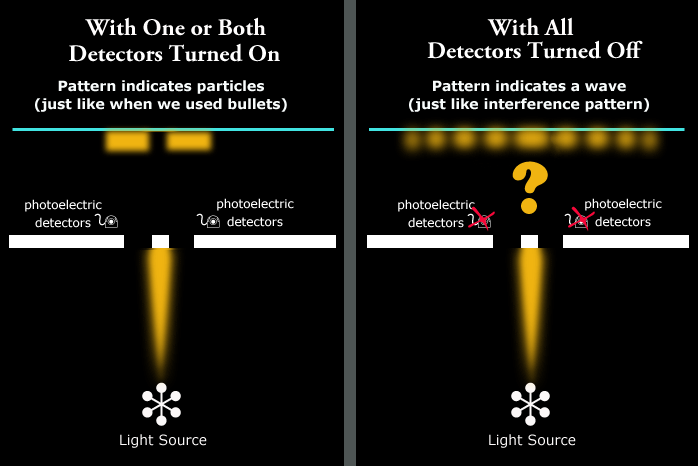 [Above left:] As soon as a detectors were turned on to observe the electron pass by, the path of the electrons striking the back wall were indicative of particles. Some would pass through the left window, then others through the right window. Over time, two distinct scatter patterns would result. This pattern would happen even if one of the detectors was turned off. Since there are only two windows, it would still be easy to determine which window was used. So the information would still allow us to "know" the path of the electron hitting the target. Right? But if you turn both detectors off, or don't even use them at all, the pattern on the target will revert to a wave pattern! Also, if you used the detectors but then didn't turn them on, or didn't look at the information coming from them (even if they are on) then the pattern will be that of a wave. The point I am trying to make here is that just by our being aware of an electron, photon or any part of the electromagnetic spectrum, we change the state of that electron from a wave to a particle. Yes, you heard correctly. Our awareness, consciousness of the material world changes that world. It gets even stranger! When does the electron change from one form to the other? Does it happen when the particle is being detected? Could the mere act of detection be enough to collapse the wave and form a particle pattern? To test his hypothesis a man named John A. Wheeler designed an ingenious way of altering the double slit experiment that would, he thought, prove that the process of detection was not responsible for the change from wave to particle patterns. First, Wheeler had two powerful telescopes -- one focused on each slit. For this experiment Wheeler used light, photons. If a photon went through one or the other slit, the telescopes could see it. The telescopes were placed where the fuzzy rectangles would register a photon hit from a particle pattern. Since the light had to travel to the telescopes, they served as a detector. Wheeler then devised a detection screen that could be very quickly placed in front of the telescopes, after the photons left their source, preventing them from reaching the detectors (telescopes) but recording where the photons landed on the screen. So what he was attempting to do was to record the photons paths before and after they were detected. The mechanism [Below:] was constructed so that the distance between the wall with the slits was quite far from both the removable detection wall and the telescopes. Because these distances and speed of light were known, it was possible to know when a photon had been released, passed through either or both of the slits and was somewhere between the slits and the telescopes. We call this time =x in the animation below. At this precise moment the detection screen could either be placed in front of the telescopes or removed. [See animation below]
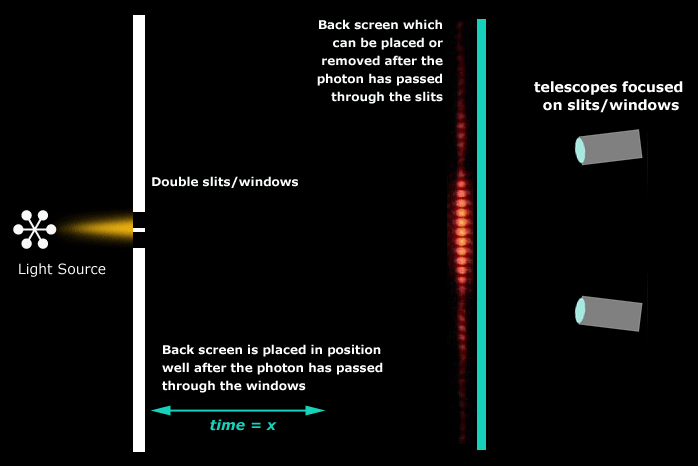 The idea was that the photon should have already decided if it was going to react like a particle or a wave after it had passed through the slits and "noticed" it was headed for the telescopes where it would be observed. And this decision by the photon should be irreversible. I mean, it's after passing through the slits so how can it change? By putting up the screen after the photon passed the slits, but before the telescopes received the light, Wheeler expected the photon would act like a particle. He expected to see two fuzzy rectangles on the detection screen. (Is your head spinning yet?) In the actual experiment, when the photons passed through the slits, if the detector wall was quickly put in place, they displayed the wave pattern on the wall. But, if after the photons passed through the slits, the detector wall was suddenly removed, the telescopes would capture the photons in the area where two fuzzy rectangles would be -- indicative of a particle. The decision on which type of detection is used (screen or telescopes) was being made after the photons have passed through the slits -- presumably after they have already decided to be a wave or a particle. It is as if the photons realized they were being tricked, went back in time to before they passed through the slits and then changed their state accordingly. Ordinarily we have "cause-effect" timelines in nature. But this experiment seems to show that the effect can change the cause. And even more significant is the fact that our own observation is the thing altering the cause. In other experiments, the detectors were used to determine through which slit the photon passed but the electronics that reported or recorded the results were turned off. This is the so-called Earasure Paradox because, despite being detected, because no human was aware of this, the interference (wave) pattern resulted. It seems that it is not the detection that matters but whether a human mind is aware of it or not!
|
Whew!
Remember, these experiments were conducted on individual electrons and photons. In real life, we observe electrons and photons everywhere. Just turn your head and you are observing light, feeling heat and interacting with electrons. This is the basis of our material reality yet, according to these facts, we are also concurrently creating the reality, collapsing waves into particles.
What happens to matter and energy that is not being observed? Is it in a wave form? Are things only "real" when we observe them?
One of the questions I had was the necessity for the observer to be "human" consciousness -- what about an animal? Does my dog see collapsed particles or does he live in an ocean of waves? What about plants? The problem has yet to be resolved because whatever experiment can be designed, involving animals or plants, the end result is that a human consciousness will eventually "know" the results!
So how can we humans do this? What kind of beings are we that we can have this affect on the fundamental particles of matter and energy?
Are you with me so far? I can easily lose you on this one, I know, so please let me know. It takes some real deep thinking and you can almost feel your mind resisting to accept the inevitable truth. Hang in there...
If you have the time, there is a wonderful video of Nobel Prize winning physicist, Richard Feynman, describing this double-slit phenomenon. A brilliant yet humble man, Feynman spoke with a Brooklyn accent that seemed to contradict his knowledge and education. He was a thoroughly entertaining teacher, even in his younger years. If you decide, the video is below:
As I was about to write the last few pages on this story I have been threatened and warned not to proceed. But I will continue, soon. In the meantime, here is a verbal description of the facts that Dr. Feynman covered in the video -- LINK HERE
[inhale...] Weird- yes? More later.
